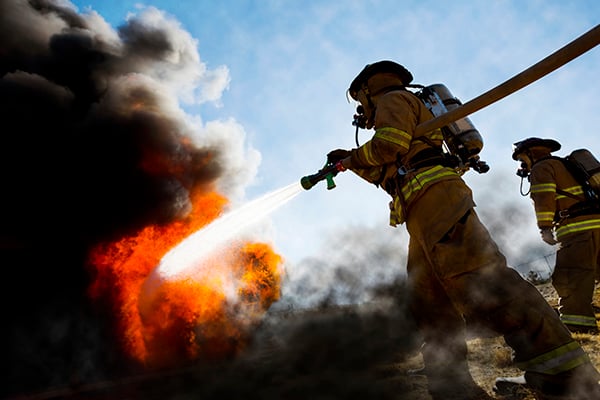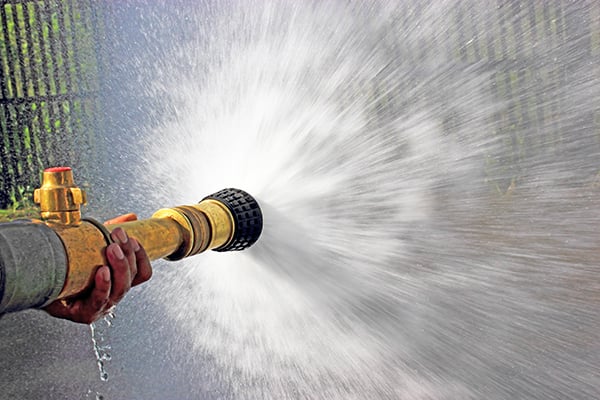Blog Post
Nozzle Knowledge: Types, Spray Patterns, and Uses of Fire Hose Nozzles
Feb. 8, 2023

Imagine trying to insert a screw with a hammer or cutting a steak with a saw. While these tools would technically get the job done, using the correct tool is safer and more efficient. This same principle can be applied to fire hose nozzles.
Everyone knows a hose with a nozzle is needed to put out a fire, but did you know there are different types of fire nozzles? Fire hose nozzles vary by type, spray patterns, threads, and the materials they can disperse.


Photo courtesy of iStock
Types of Fire Nozzles
In 1964 the National Fire Protection Association (NFPA) created a set of standards outlining performance requirements for nozzles used in fire suppression. These standards were updated in 2018. The revised standards divide hose nozzles into four categories: basic, constant gallonage, constant pressure, and constant/select gallonage.
Basic
Basic nozzles are fire hose nozzles with an adjustable-pattern spray. The rated discharge is delivered at a designated nozzle pressure and setting. The gallons per minute (GPM) and PSI of the nozzle vary as the stream shifts from straight to fog.
Constant Gallonage
Constant gallonage nozzles are also adjustable-pattern spray nozzles. However, they discharge at a constant rate through a range of patterns, straight to wide, at a designated pressure. As the nozzle pattern changes, the orifice size remains the same to maintain a fairly constant GPM.
Constant Pressure
Also called automatic, constant pressure nozzles are self-explanatory. The pressure on these nozzles remains relatively constant through a range of discharge rates. The spray pattern is adjustable, and the operator can choose from one of several different orifice sizes. This nozzle style helps guarantee stream reach with a self-adjusting component to keep the pressure steady.
Constant/Select Gallonage
Constant/select gallonage nozzles have a constant discharge rate which allows for manual adjustment to effect a predetermined discharge rate while the nozzle is flowing.


Photo courtesy of iStock
Spray Patterns
Another defining aspect of fire hose nozzles is the spray patterns the nozzle supports. The spray pattern is defined as the shape of the water as it exits the nozzle. The two most common types of spray patterns are fog and straight stream.
Fog
Fire hose nozzles with a fog spray pattern expel a cone-shaped stream of small water droplets. The droplets are easily converted into steam, which helps take hot air out of a room.
Straight Stream
Water from straight stream nozzles is discharged in the shape of a column. These nozzles offer greater reach but are not as effective for ventilating space or absorbing ambient heat.
Uses/Applications
Fire hose nozzles are obviously used to help put out fires, but the material discharged from the nozzle depends on the type of fire.
Fires are categorized based on what caused the fire or what the fire uses as fuel. There are five different classes of fires: A, B, C, D, and K.
Class A fires are the most common. They occur when materials such as fabric, paper, and wood combust. Class A fires can be extinguished with water.
Class B fires involve flammable liquids and gases. Petroleum, gasoline, paint, propane, and butane fall into this category. Class B fires are best extinguished by smothering them or using foam to remove the oxygen.
Class C fires are electrical fires. A non-conductive material is required to extinguish these fires, so water is not a good solution. Instead, clean agent suppression is the ideal way to handle a class C fire because it won’t leave a residue or damage electrical equipment.
Class D fires are known as metallic fires. These fires involve materials like potassium, titanium, magnesium, and aluminum, which are all common in laboratories. Although Class D fires are not common, they require special attention because they are difficult to extinguish. Using water on a metallic fire will only intensify the situation, so dry powder agents are the best option.
Class K fires are grease or cooking fires. While similar to Class B fires, because they involve flammable liquids, Class K fires are specific to the food service industry. These fires are caused by the combustion of grease, oils, and animal fats. Water can make these fires worse, so smothering the flames or using a wet agent fire extinguisher is recommended.
What does all of this have to do with fire hose nozzles? Understanding the type of fire at hand helps hose operators know what media and type of nozzle should be used to extinguish the flames. Most fire nozzles can be used with water, but some are also approved to disperse other media, such as an aqueous film-forming form (AFFF), which is beneficial depending on the type of fire. For example, Dixon offers a U.S. Coast Guard Approved AFFF/Water Fog Nozzle that can be used with water or foam depending on the situation.
Threads
Another thing to consider when selecting a fire hose nozzle is the threads. Threads are what connect the nozzle to the hose. All nozzles have threads, but not all threads are the same. Therefore, users must consider the compatibility between nozzles and hoses. The main thread types for fire hose nozzles are National Standard Thread (NST), National Pipe Straight Hose (NPSH), and National Pipe Thread (NPT).
NST threads, also called National Hose (NH) threads, are the most widely used fire thread standard in the U.S. NPSH threads have the same threads per inch as NPT, but the threads do not taper. NST and NPSH are both straight threads, but they are not compatible. Having hoses and nozzles with different, incompatible threads creates a dire situation, putting lives and property at risk.
Read our Threads 101 blog post to learn more.
Dixon’s Fire Hose Nozzles
Dixon offers a variety of fire hose nozzles to meet the needs of your application.

Features:
- Straight stream, capable of more than 100° spray angle
- Twist shut off and flow-type change
- Threads: NPSH, NST, or made to order
Specifications:
- Maximum working pressure: 100 PSI
- Maximum rated pressure: 175 PSI
- Rated flow at rated pressure (GPM):
- 3/4”: 54
- 1”: 60
- Rated flow at wide open GPM at 100 PSI:
- 3/4”: 54
- 1”: 60
- FM approved for class A and B fires
- UL listed for class A and B fires
 Features:
Features:
- Delivers 30°-60° fog pattern - shutoff to 30° fog, excess of 100° fog
- Supplied with bumper
Specifications:
- Maximum working pressure: 100 PSI (water only) at 70°F (21°C)
- Wide open GPM at 100 PSI: 96
Approvals:
- FM approved for class A and B fires
- UL listed for class A and B fires
Use:
- For use with water only
Domestic FM Approved Polycarbonate Fog Nozzle

Features:
- Shut off - straight stream - fog
- Wings on sleeve for ease of adjustment
- Maximum operating pressure: 100 PSI (water only) at 70°F (21°C)
- 90° spray GPM at 100 PSI:
- 3/4”: 30.9
- 1”: 30.9
- 1-1/12”: 75
- Factory Mutual approved
Construction:
- Brass stem with locking nut
- Polycarbonate
Use:
- For use with water only
U.S. Coast Guard Approved AFFF/Water Fog Nozzle with Pistol Grip
 Features:
Features:
-
Double row of molded teeth for excellent fog pattern
Flush without shutting down
Constant gallonage in all fog and straight stream patterns
Combination fog and straight stream
- 95 GPM fog at 100 PSI
Construction:
- Corrosion-resistant brass construction
- Rubber-like bumper and handle for added protection
- Zytel® (nylon) horseshoe handle
Use:
- For use with water/Aqueous Film Forming Foams (AFFF) only
- Nozzles are designed for maximum efficiency with AFFF or water on shipboard, offshore rigs, and industrial applications

Features:
- Shut off - straight stream - fog
- Delivers 30° - 60° - 90° fog pattern
- Supplied with bumper
Specifications:
- 90° spray GPM at 100 PSI:
- 1”: 32
- 1-1/2”: 85
- 2”: 108
- 2-1/2”: 205
- UL Listed, ULC Listed, and Factory Mutual approved for class A and B fires
Use:
- For use with water only
 Features:
Features:
-
1-1/2” ball shutoff nozzle
Swiveled female inlet
Specifications:
- Maximum working pressure: 100 PSI
-
Constructed of hard anodized aluminum
Handle is made of composite material
 Features:
Features:
-
Full-time swivels and spinning teeth
BIMATIC flush system allows flush without shutting down
Removable pistol grip
Specifications:
- GPM at 100 PSI:
- 1-1/2”: 60-95
- 2-1/2”: 150-200
Construction:
- E-Lite aluminum and brass internals
 Features:
Features:
-
Four gallonage selection rings:
-
30, 60, 90, and 125 GPM
-
GPM at 100 PSI: 30-125
-
GPM at 100 PSI: 15-60
Construction:
- E-Lite aluminum and brass internals
 Features:
Features:
-
Four gallonage selection rings: 5, 10, 25, and 40 GPM
Available without pistol grip
Specifications:
- GPM @ 100 PSI: 5-40
Construction:
- E-Lite aluminum and brass internals
This is a small sampling of the fire hose nozzles Dixon offers. For more information visit dixonvalve.com.
Conclusion
While they may be easy to use, there is a lot more to selecting a fire hose nozzle than most people realize. Understanding the difference between basic, constant gallonage, constant pressure, and constant/select gallonage nozzles is just step one of the process. Being aware of the different thread types and spray patterns is also imperative.
Dixon is proud to manufacture and supply a diverse line of fire protection products, including interior sprinkler and standpipe components, valves, adapters, fire hose, racks and reels, fire department connections, and nozzles. For recommendations on your specific application, contact us online or call 877.963.4966.
 US | en
US | en